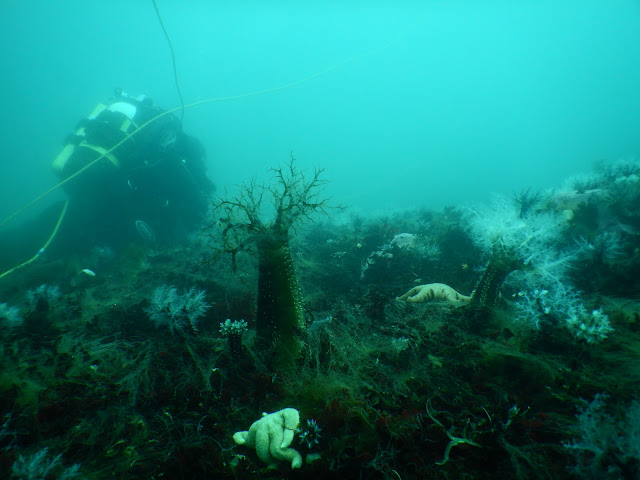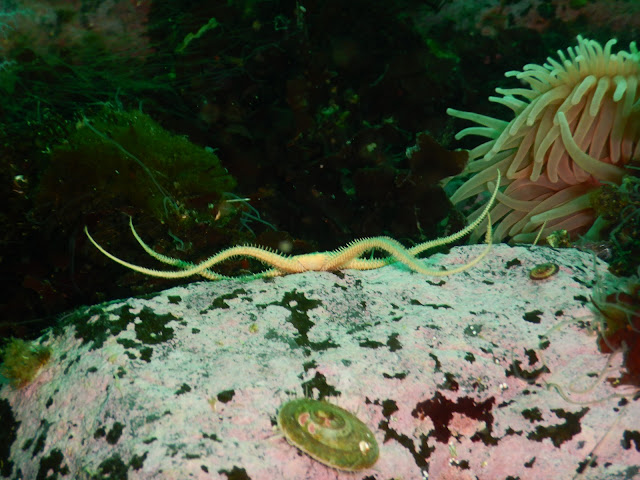I first experienced the marine team as a group of eight people comprising two of each of the following positions: boating officer, diving officer, marine assistant and marine biologist. Across two short months the old wintering team and the new wintering team handed over to each other. For the new incoming team we had to learn how best to conduct complex polar diving operations in a very short amount of time. The days flew by, as we were tasked with continuing existing science projects whilst pursuing new ones.

Exploring the local dive sites with the outgoing Marine Biologist, Joe Marlow.
Our offices are spread across diverse locations: at the southern end of the station in the Bonner Laboratory, in the boat shed and, of course in the Southern Ocean! Typically we start our day with a morning boat briefing at 08:30 where we discuss the weather trends for the day (wind speeds, wind direction, swell, visibility and pressure) and adapt our scientific priorities according to the constraints. If given the greenlight, we swiftly prepare our kit for diving and load it onto our dive boat. We use a tractor to tow the boat through snow tracks to the wharf where a crane launches the boat into the water. In the meantime, a dedicated 30 minute seal watch is underway in the vicinity of our dive site to monitor the area for leopard seals on ice floes or in the water, as well as to scan the horizon for orca dorsal fins. The divers (usually the marine assistant and marine biologist) will stay inside to keep warm for as long as possible as we dress into our drysuits and fluffy robes (some joke that we look quite like little red riding hood, I on the other hand, feel like royalty!).


Travelling to the dive sites and passing ice bergs
Ryan travelling in style on the dive boat- nice and toasty!
Diving set up from the boat
Typical dive kit set up from the shore
As I have touched on during previous posts, the water temperatures in Antarctica are relatively thermally stable and vary only a matter of degrees from +2°C in the summer to -1.8°C (the freezing point of water) in the heart of winter. Fortunately, we took our first polar plunge in December, which in the southern hemisphere, is the height of the summer. The days are characterised by 24 hours of sunlight which drive the most intense phytoplankton bloom worldwide. As opposed to clear, blue nutrient depauperate winter waters, the water column was green, teeming with chlorophyll found amongst photosynthesising plankton. This is a really productive period for sea floor organisms (scientifically known as benthic species) and during my first dives, I observed sea cucumbers feeding with outstretched tentacles. Benthic species respond to strong seasonal cues: the increase in light brings food in the form of phytoplankton and the 'warmer' summer temperatures can instigate the transition out of winter dormancy. The sea cucumber species photographed below can go into a state of dormancy for up to 4 months (generally from June-October). During this period, the sea cucumbers will retreat below the rocks, making them difficult to find.


A dominant seafloor organism- sea cucumber (Heterocucumis steineni), clearly feeding with outstretched tentacles.
Some individuals are enormous and almost resemble a small tree (for scale, this individual is about 60 cm tall).
When diving in and around our sites at Rothera Research Station, we encounter three species of sea cucumbers which are relatively common (Cucumaria georgiana, Heterocucumis steineni, Echinopsolus charcoti). But in actual fact, 187 different sea cucumber species have been recorded in the Southern Ocean and interestingly comprise 4% of all Antarctic marine species.
A different species of sea cucumber- (Cucumaria georgiana)
A forest of sea cucumbers surrounding an anemone
Sea cucumbers are classified into a larger taxonomic grouping: Echinoderms . In addition to sea cucumbers, the group comprises sea stars, brittle stars, urchins and feather stars, which are defined by their 5-point radial symmetry.
Other common seafloor organisms include the cushion sea star. Although innocent looking, this animal has a voracious appreciate and is capable of filter-feeding and eating a varied diet of organic material, small crustaceans (shrimp-like and wood-louse looking creatures), sponges, algae, sea urchins, worms and even seal faeces!
A cushion sea star- Odontaster validus
The brittle star uses two leading arms in a rowing fashion as it moves along the seafloor in search of food. This species is an opportunistic predator, a scavenger and a detrital feeder. This species also engages in cannibalism which involves adults eating juveniles... I imagine I've changed your perception of marine life (or at least of the 'innocent' starfish)!
A brittle star- Ophionotus victoriae
The most exciting species I've encountered so far is the 40-arm starfish. I've been looking ever since, but have not yet come across another one. Its 'arms' are referred to as rays which it uses to move along the seabed. The rays search for prey and are fitted with claw-like appendages that can snap up prey efficiently.
The 40-arm starfish, Labidiaster annulatus
At Rothera, we are incredibly fortunate to be able to regularly dive below the waves and marvel at the abundance and diversity of life on the seafloor. Currently, my projects are focused on monitoring the growth rates of key benthic species across the seasons, taking regular measurements to capture periods of de-growth and peak growth. In addition to monitoring changes in biomass, by temporarily putting species in respiration chambers, I can obtain measures of oxygen consumption which will tell me about an organism's metabolism- ie. how much oxygen they are using in a set period of time. I then deploy the experimental species back into the field and allow them to go about their daily lives before conducting measurements in the following season. To supplement these studies, examining the faeces of an animal offers a fantastic insight into what they are eating ...
Obtaining respiration data for sea cucumbers in the aquarium!
Antarctic diatoms (members of the phytoplankton) found amongst sea cucumber faeces
Another project I am working on is tracking the fate of carbon held within photosynthesising marine plants: algae. I have installed an underwater experiment measuring the breakdown rates of various Antarctic seaweed species. I am interested in the species responsible (ie. amphipods, isopods,) for eating the algae and tracking the movement of this carbon through the food chain. Collecting the community of organisms living on the algae at various time intervals, permits an understanding of the succession of the invertebrate grazer community through time.
Underwater algae forests
An experimental approach to measuring the breakdown of algae
Underwater scenes of myself and Ryan
Surfacing after a dive
More obscure and potentially less familiar species such as sea spiders are a delight to encounter. You may be surprised to learn that Antarctica hosts 20% of the sea spider species class - pycnogonida.

A sea spider
The winter is fast approaching and daylight is diminishing. The water is becoming increasingly colder and we are starting to loose sensation in our hands at a much faster rate. Under our drysuits, we are increasing the thermal protection and adding more weight to our belts to offset the increased buoyancy. Much of the lush algae carpets will soon be dying back and the feeding tentacles of sea floor species will retreat. Just as the seasons dramatically affect forests on land, we are expecting to see marked changes at our dive sites.





























Thanks for sharing. Interesting to see things closing down there, while they're ramping up here - makes it feel more like one world.
ReplyDeleteI love that analogy John!
DeleteYour post carries a lot of important information. I have found some information in this post that I and everyone need to know. Looking for Divemaster Maldives? Check the best diving atoll Maldives on Jerrys Drive Club. Get special discounts on
ReplyDeletedive center maldives
Awesome! Thank you so much for sharing these kinds of information. Keep writing and updating something on Dive Instructor Phuket.
ReplyDelete